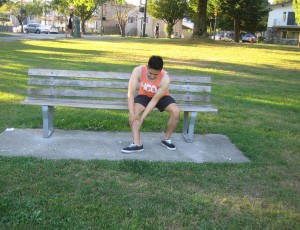Muscle cramps are characterized as involuntary and abrupt contraction of muscles that do not relax. Cramps can affect any muscle under voluntary control. Take note that muscles that cover two joints are at higher risk for cramping. A muscle cramp can affect a part or the entire muscle as well as several muscles in a particular group.
The muscle groups commonly affected by muscle cramps include the back of the thigh, back of lower leg or calf and the front of the thigh. Cramps that occur in the hands, feet, arms, and abdomen and along the rib cage are also common.

Who are at risk for getting muscle cramps?
Any individual can experience a muscle cramp at some point in their lives. A cramp can occur while swimming, bowling, playing tennis or performing your exercise routine. It can also manifest while sitting, walking or even sleeping. Take note that even a slight movement that can shorten the muscle can elicit a cramp.
Individuals who are at high risk for cramps are the endurance athletes as well as older individuals who engage in strenuous physical activities.
Athletes are susceptible to cramps if their bodies are not properly conditioned. Take note that cramps usually occur after an intense exercise routine or 4-6 hours later. Older individuals are also prone to muscle cramps due to the loss of muscle that starts at the mid-40s and progresses due to inactivity. Due to the aging process, the muscles could not work hard as they used to.
Causes of muscle cramps
The exact cause of muscle cramps is still unknown. It is believed that it is due to lack of stretching as well as muscle fatigue. Other possible factors that can increase the risk for cramps include exercising or working under intense heat, poor conditioning, depletion of salt and minerals as well as dehydration.
Even though some cases of muscle cramps are considered benign, they often indicate an underlying medical condition. It is important to consult your doctor if the cramps are severe, occur frequently, not related to the common causes and respond poorly to simple treatments. It might indicate problems with the circulation, hormones, metabolism, intake of certain medications and nutrition.
[youtube url=”http://www.youtube.com/watch?v=1ZeMEaBLU00″]Muscle cramp symptoms
Muscle cramps usually range from a minimal tic up to those that cause extreme pain. A muscle that cramps typically feels hard to the touch and appears distorted or twitches. It can last for a few seconds or longer and can recur several times before it eventually vanishes.
How muscle cramps are treated
It is a known fact that muscle cramps typically go away without requiring medical interventions. There are certain steps to take once an individual experiences a cramp:
- Stop the activity that elicited the cramp.
- Apply heat to the tense muscles while cold for tender muscles.
- Stretch gently and massage the affected muscle by holding it in a stretched position until the cramp stops.
The best way to prevent muscle cramps from occurring is to improve your overall fitness. This is possible by performing regular flexibility exercises before and after workout to stretch the muscle groups at high risk for cramps.
